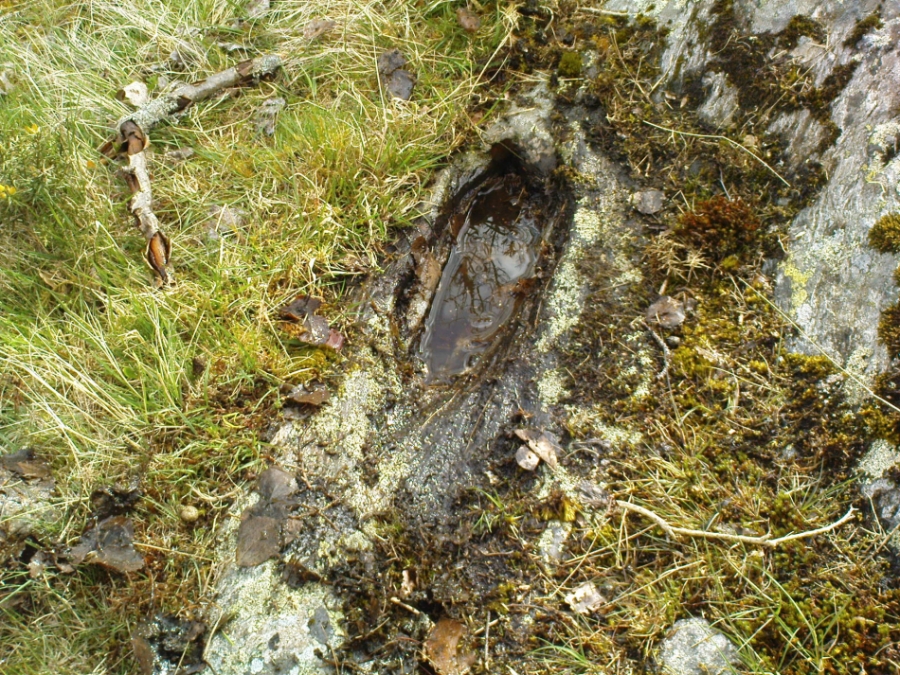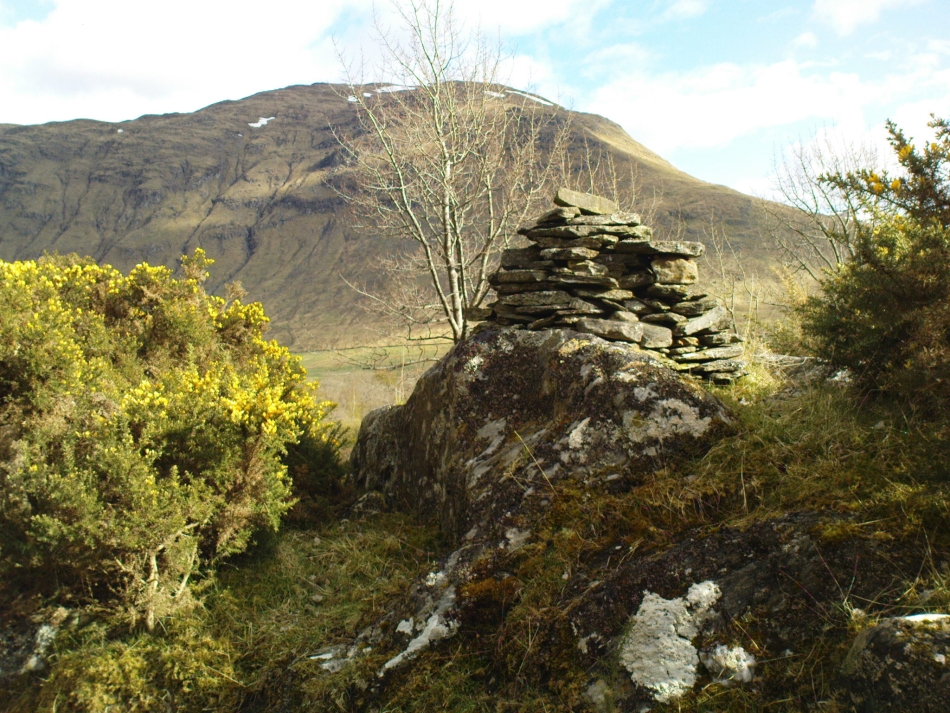Legendary Stone: OS Grid Reference – NN 62626 47685
Also Known as:
- Craig Dianaidh
- Rock of Safety

From Fortingall, get to the standing stone of Adamnan’s Cross a few miles down the stunning Glen Lyon. Barely 100 yards before you reach the stone, notice the overgrown gorse-covered rocky rise across the road, just past Craigianie Farm. As you climb to the top of this small rocky rise, you’ll see a cairn of stones on its top. Just below it, into the solid rock, you’ll see a footprint-shaped hollow etched into the stone. If it seems hidden, just keep looking – you’ll find it…
Archaeology & History

When Ratcliffe Barnatt (1944) visited Glen Lyon in the 1940s, this legendary rock was one of his stopping points. “When we have passed by Ruskich and Slatich,” he wrote, “we come to that sacred spot, Craig Dianaidh, the Rock of Safety, where, until about 1480, solemn and judicial meetings were held.” The old rock was known through recent ages, “as a preaching hill, a motehill and a justiciary court,” said Hilary Wheater (1981), and upon its top is the curious ‘footprint’ which Nature’s blood would fill on all but the hottest of summers. It is this geological feature that gave the stone is name, long ago.
Of known historical events here, Wheater further told:
“It was on this rock…that the Baron Courts of Glenlyon were held. Law and order was kept by regular courts held by the Chief or Landowner. The Baron-Bailiary of each area was appointed by Royal Charter. Fifteen men were chosen as a jury and the laird or his baile presided. To this court were brought all the problems and grievances of the people. Here the miller accused several men of refusing to take part in the compulsory ‘hamganging’ of a new millstone; here a man was fined for brewing ale without a license; here a neighbour was accused of putting the ‘evil eye’ on the cow of the croft next door so it produced no milk; and here a man was prosecuted for ‘taking of ane sore horse of his to Rannoch in the summer of 1629 and putting on him ane great burder of timber, and letting him go through the wood where he stuck between two trees all night and the timber on his back.’ However, he was acquitted when he was able to prove that the horse was fit enough after this for another man to be able to take it to Edinburgh soon after.”

As well as being a moot site, it is more than probable that this footprint, like the one near the top of Dunadd in Argyll—and others scattering the Highlands and beyond—was an initiation stone, perhaps for local tribal elders or ancient kings. Janet Bord (2004) writes about them as places of ritual inauguration in her survey of such places.
Folklore

This legendary rock would probably have had earlier mythic association than the one ascribing it to St. Palladius—but as yet I have found no written lore telling the nature of such a spirit, so would only perhaps discern the original genius loci by lengthy encounters with the rock in question, through mist and storm and wintry months, alone. It is known in local folklore that Palladius was in fact an urisk: a solitary spirit of steep streams that few humans encounter due to their lonely habits amidst hidden abodes in dark and ancient gorges. Such urisks dwelt in numbers amongst many of the steep falls in this landscape — and still do, if the words of old locals are to be believed. Here,
“St Palladius was a goblin saint, an urisk that dwelt in a mountain burn and was sanctified by the people.”
…and some rocks by the stream up the mountain immediately above this “footprint” was one of the places the urisk was known to dwell.
…to be continued…
References:
- Barnatt, T. Ratcliffe, The Road to Rannoch and the Summer Isles, John Grant: Edinburgh 1944.
- Bord, Janet, Footprints in Stone, Heart of Albion Press 2004.
- Fraser, Duncan, Highland Perthshire, Standard Press: Montrose 1969.
- Wheater, Hilary, Aberfeldy to Glenlyon, Appin Publications: Aberfeldy 1981.
© Paul Bennett, The Northern Antiquarian
St Palladius was a pre-Patrician saint who was an apostle and missionary before the time of St Patrick. He spent much of his life in Ireland, especially in Co.Wicklow where churches at Tigroney, Donard and Cilleen Cormac are thought to have been founded by him. Scottish tradition says he spent 23 years as a missionary in that country?
Source: Farmer, David., Oxford Dictionary Of Saints (5th edition), Oxford University Press, 2003.
Lovely post, capturing the mysterious and ambiguous nature of ancient sites like this. Palladius was a goblin long before he was a saint….old nature beliefs became entwined with newer wonder tales of the saints….the saints sanctified power spots known far back into antiquity 🙂
I always image Druids standing on one foot ( crane dancing) and weaving their magic into and out of the land, in these carved footprint stones! But then I do have a vivid imagination 🙂
You might find this reference on the Clan Donnachaidth website interesting.
https://robertson.org/OOTC_Saint_Adamnan_of_Dull.html